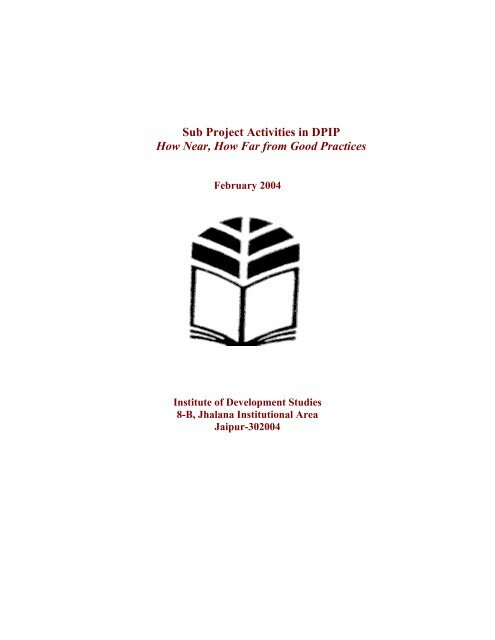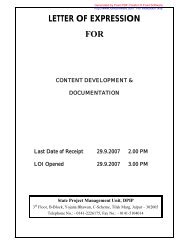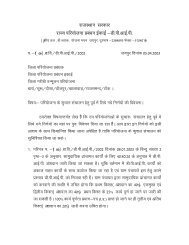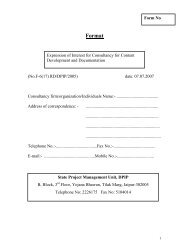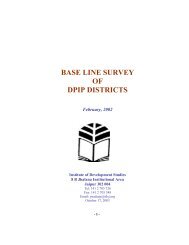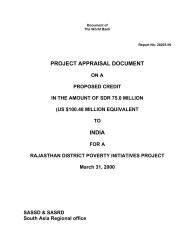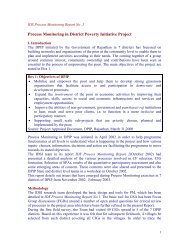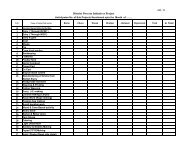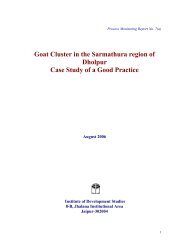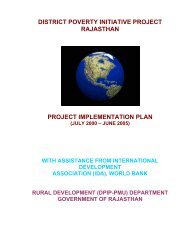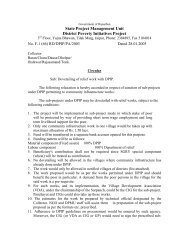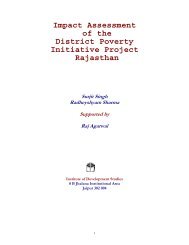Sub Project Activities in DPIP How Near, How Far from Good Practices
Sub Project Activities in DPIP How Near, How Far from Good Practices
Sub Project Activities in DPIP How Near, How Far from Good Practices
You also want an ePaper? Increase the reach of your titles
YUMPU automatically turns print PDFs into web optimized ePapers that Google loves.
<strong>Sub</strong> <strong>Project</strong> <strong>Activities</strong> <strong>in</strong> <strong>DPIP</strong><br />
<strong>How</strong> <strong>Near</strong>, <strong>How</strong> <strong>Far</strong> <strong>from</strong> <strong>Good</strong> <strong>Practices</strong><br />
February 2004<br />
Institute of Development Studies<br />
8-B, Jhalana Institutional Area<br />
Jaipur-302004
<strong>Sub</strong> <strong>Project</strong> <strong>Activities</strong> <strong>in</strong> <strong>DPIP</strong><br />
<strong>How</strong> <strong>Near</strong>, <strong>How</strong> <strong>Far</strong> <strong>from</strong> <strong>Good</strong> <strong>Practices</strong><br />
Introduction<br />
The District Poverty Initiatives project (<strong>DPIP</strong>) has been <strong>in</strong> place for the past 2 ½<br />
years. The Common Interest Groups (CIGs) formed with<strong>in</strong> the project have moved<br />
<strong>from</strong> their <strong>in</strong>fancy to a mature stage. A total of 3247 groups have been formed upto<br />
January 2004 <strong>in</strong> the 7 districts where the project is be<strong>in</strong>g implemented. Among other<br />
activities CIGs have to plan and undertake <strong>Sub</strong> <strong>Project</strong> activities (SPA) accord<strong>in</strong>g to<br />
their needs and priorities. The SPAs are expected to yield direct or <strong>in</strong>direct economic<br />
benefit to the members of the CIGs.<br />
A large number of different SPAs have been supported <strong>in</strong> <strong>DPIP</strong>. The diversity <strong>in</strong> the<br />
nature of activities po<strong>in</strong>ts to the potential of the rural economy to absorb these<br />
<strong>in</strong>terventions. Box 1. shows the different k<strong>in</strong>ds of SPA designed <strong>in</strong> the project.<br />
Box.1: SPAs designed <strong>in</strong> <strong>DPIP</strong><br />
Nature of activities<br />
Land-based activities<br />
Income generation<br />
activities (Microenterprises),<br />
Community<br />
Infrastructure<br />
Development projects<br />
Social services<br />
<strong>Sub</strong> <strong>Project</strong> <strong>Activities</strong><br />
Vegetable production, irrigation wells/tube wells, vermicompost,<br />
land improvement, horticulture, med bandi,<br />
anicuts, kund, social forestry, nursery, wasteland<br />
development and pasture development.<br />
Carpet weav<strong>in</strong>g, gem stone bead<strong>in</strong>g , livestock, dairy,<br />
munjbaan, tent house, Band, poultry, readymade garments,<br />
leather works,<br />
Tanks, anicut, school rooms, health sub-centre, gravel<br />
roads/khuranja,<br />
Community hall,<br />
Toilets, dr<strong>in</strong>k<strong>in</strong>g water<br />
The present report reviews some SPAs <strong>in</strong> <strong>DPIP</strong> with a view to learn <strong>from</strong> these<br />
examples. While several factors seem to have played a critical role <strong>in</strong> determ<strong>in</strong><strong>in</strong>g the<br />
outcomes of these <strong>in</strong>itiatives, the report also attempts to identify some key <strong>in</strong>gredients<br />
for success of a SPA. The IDSJ team made an effort to identify some completed or<br />
nearly completed SPAs, which had started yield<strong>in</strong>g economic returns. The district<br />
teams - DPMUs and the affiliated NGO partners helped <strong>in</strong> identify<strong>in</strong>g these cases.<br />
On the basis of our field-work, we dist<strong>in</strong>guish the SPAs by the follow<strong>in</strong>g:<br />
a. Characteristic design led either by environmental factors, some <strong>in</strong>novations or <strong>in</strong>put<br />
use efficiency;<br />
b. Deep market penetration through wide reach of services and creat<strong>in</strong>g demand;<br />
c. Unique manufactur<strong>in</strong>g process us<strong>in</strong>g appropriate technology and organisation; and<br />
d. Build<strong>in</strong>g on exist<strong>in</strong>g skills through augmentation of equipment.<br />
In each of the above categories, we shall discuss the relevance of the SPA to the poor,<br />
the nature of economic returns and the susta<strong>in</strong>ability of <strong>in</strong>terventions. In this manner,<br />
we also attempt to locate how far and how near SPAs are <strong>from</strong> good practice.
I. Characteristic Designs of SPAs<br />
In this section, we discuss some designs of land-based and livestock rear<strong>in</strong>g activities<br />
<strong>in</strong> different districts of the <strong>DPIP</strong>. The land based activities <strong>in</strong>clude "Integrated<br />
Agriculture Development <strong>Project</strong> (IADP)", "Land level<strong>in</strong>g" and "Goat rear<strong>in</strong>g". We<br />
shall discuss each of these <strong>in</strong> some detail.<br />
Integrated Agriculture Development <strong>Project</strong> (IADP)<br />
Integrated Agriculture Development <strong>Project</strong> (IADP) is a farm-plann<strong>in</strong>g project based<br />
on available resources to the farmers. The objective is to diversify the crop<br />
composition, make rational use of water and maximise the returns to water and other<br />
<strong>in</strong>puts.<br />
The ma<strong>in</strong> components of the scheme are the follow<strong>in</strong>g:<br />
(i) Irrigation systems: diesel eng<strong>in</strong>es and accessories are provided for the group<br />
of farmers.<br />
(ii) Spr<strong>in</strong>kler sets and delivery pipes: While those not hav<strong>in</strong>g irrigation facilities<br />
so far jo<strong>in</strong> the lot of irrigated farmers along with spr<strong>in</strong>kler sets, others<br />
economise use of water us<strong>in</strong>g spr<strong>in</strong>klers.<br />
(iii) Cropp<strong>in</strong>g pattern: <strong>Far</strong>mers are encouraged to grow vegetables, long term<br />
plantations and a green fodder plan for the entire year along with gra<strong>in</strong>s,<br />
pulses and oilseeds. They are also encouraged to grow munj on the farm<br />
boundaries.<br />
(iv) Vermi compost: The available cow dung is processed to produce Vermi<br />
compost. A shed is constructed for which a provision of Rs 11,000 is made.<br />
Vermi compost reduces the cost of cultivation, decreases the <strong>in</strong>cidence of<br />
pests and <strong>in</strong>sects, <strong>in</strong>creases productivity <strong>in</strong> the long run ensur<strong>in</strong>g susta<strong>in</strong>able<br />
agriculture.<br />
(v) Storage of foodgra<strong>in</strong>: Brass tankies are provided for stor<strong>in</strong>g foodgra<strong>in</strong> as the<br />
(vi)<br />
capacities of the poor farmers to store their own produce is poor.<br />
Other components: Mach<strong>in</strong>es such as those used for spray<strong>in</strong>g and ferron traps<br />
are also provided.<br />
The total project cost of the IADP ranges between Rs 150,000 and Rs 450,000.<br />
Land level<strong>in</strong>g <strong>Project</strong> have mostly been undertaken <strong>in</strong> the Rajsamand district, which<br />
is characterised by undulat<strong>in</strong>g mounta<strong>in</strong>ous terra<strong>in</strong>. The <strong>in</strong>itial step <strong>in</strong> the <strong>Project</strong> is to<br />
level the land manually, and clear the land of the larger boulders. The stones so<br />
obta<strong>in</strong>ed are used to construct the medbandi/boundary wall, which conserves soil and<br />
water. <strong>Sub</strong>sequently, fruit trees may be planted and <strong>in</strong>ter-tree cropp<strong>in</strong>g encouraged.<br />
The land can also be used for other agriculture purposes.<br />
Livestock rear<strong>in</strong>g SPAs have been promoted <strong>in</strong> almost all districts. The ma<strong>in</strong> feature<br />
is construction of a shed, which helps to keep wild animals at bay, and provide<br />
shelter <strong>from</strong> excessive heat, cold and ra<strong>in</strong>. Livestock get space to lie down and their<br />
hoofs are also protected <strong>from</strong> worms and <strong>in</strong>sects, as sanitation is taken care of. Feed<br />
and fodder are also not wasted as provisions are made for their storage and thaan.
Relevance to the Poor<br />
These projects have evolved over almost a year. Initially they entailed us<strong>in</strong>g only a<br />
few <strong>in</strong>puts: say a diesel pumpset and spr<strong>in</strong>klers <strong>in</strong> the IADP, simply level<strong>in</strong>g the land,<br />
and <strong>in</strong> case of livestock rear<strong>in</strong>g provid<strong>in</strong>g 15 goats and a he-goat. Later other<br />
components like vermi compost, horticulture, and construction of animal shed were<br />
added to the project design. This shows that as the understand<strong>in</strong>g about the poor, their<br />
needs, and the environment <strong>in</strong>creased among the DPMU and the NGOs, they looked<br />
for technological solutions available and the project design was ref<strong>in</strong>ed. The result is<br />
that the SPAs addressed the environmental needs, susta<strong>in</strong>ability aspects, and efficient<br />
and optimum use of water as well as "m<strong>in</strong>or" needs of the farmer households.<br />
Nature of Economic Returns<br />
The Bhoomiya Baba Samooh at Dabar Kalan, Dausa, put up a proposal for Integrated<br />
Agriculture Development with a proposed budget of Rs. 1,33,000. The Group<br />
purchased a diesel pump set. Each member has also received 20 pipes each for the<br />
spr<strong>in</strong>klers. In addition the group purchased two net frames and 3 sprayers. So far the<br />
Group has sown two vegetable crops of tomato and green chillies and each member<br />
has made profits to the tune of Rs 10,000. The Group has also taken <strong>in</strong>terest <strong>in</strong> vermi<br />
compost and has used the manure thus produced to successfully <strong>in</strong>crease the rabi<br />
production. It is also <strong>in</strong> the process of apply<strong>in</strong>g for an additional pump set. In the case<br />
of land-level<strong>in</strong>g projects, the CIGs who had used safed musli for horticulture<br />
plantation had to face a crop failure due to drought. <strong>Sub</strong>sequently, they have planted<br />
ber and hope to take one more crop yield<strong>in</strong>g annual benefit of Rs 2000-5000 per year.<br />
Susta<strong>in</strong>ability of Interventions<br />
The susta<strong>in</strong>ability factor is largely built <strong>in</strong>to the design of the SPAs discussed above.<br />
Use of organic farm<strong>in</strong>g, water harvest<strong>in</strong>g structures and sheds for animals are<br />
<strong>in</strong>terventions which the poor may not have been able to take on their own without the<br />
design <strong>in</strong>put and f<strong>in</strong>ancial support of the <strong>DPIP</strong>.<br />
II. Market penetration<br />
The SPA for tent house provides for hir<strong>in</strong>g of a large shop space vary<strong>in</strong>g between<br />
180-250 square feet. The place is generally selected where transport is accessible.<br />
Along with items such as utensils and rugs, some CIGs have also added electric<br />
fitt<strong>in</strong>gs for decoration and a generator-set to their assets. A sew<strong>in</strong>g mach<strong>in</strong>e is also<br />
procured for sew<strong>in</strong>g torn tents. These articles are rented out to the community. The<br />
rent<strong>in</strong>g activity is organised by the group collectively.<br />
The Tent House project meets the demands of all groups <strong>in</strong> the village and the<br />
neighbour<strong>in</strong>g villages. In many villages the equipment used to be hired <strong>from</strong> far-off<br />
places. The market for tent house is far <strong>from</strong> saturated. The demand for tent house is<br />
sporadic but is high dur<strong>in</strong>g the marriage season. The sporadic demand <strong>in</strong> the past<br />
rema<strong>in</strong>ed largely unfulfilled as it was too expensive to transport just a few accessories<br />
such as cots, and chairs <strong>from</strong> distant towns where tent houses were located. In that<br />
sense, the demand rema<strong>in</strong>ed unmet. Nevertheless, the demand could be partially met<br />
by borrow<strong>in</strong>g the equipment <strong>from</strong> the neighbourhood or the village panchayat. In this
manner, we f<strong>in</strong>d that new markets have been created with<strong>in</strong> villages and markets<br />
outside the village have been penetrated.<br />
Relevance to the Poor<br />
The poor are now able to meet their demand with<strong>in</strong> the village: the costs of hir<strong>in</strong>g are<br />
substantial lower, the equipment is new and clean, and adds to the social-status and<br />
self- image of those hir<strong>in</strong>g-<strong>in</strong> these articles. For the CIG members it has meant<br />
work<strong>in</strong>g together and manag<strong>in</strong>g the enterprise. It rema<strong>in</strong>s to be seen how the newly<br />
acquired skills would benefit them <strong>in</strong> the long run.<br />
Nature of Economic Returns<br />
The Jai Shankar Samooh <strong>in</strong> Angai, Dholpur purchased a number of items such as<br />
tents, generator-set, chairs, mattresses, utensils, crockery, and sew<strong>in</strong>g mach<strong>in</strong>e<br />
spend<strong>in</strong>g Rs 2.5 lacs. The members were wait<strong>in</strong>g for the release of the third<br />
<strong>in</strong>stallment to purchase more items. The group has taken 3 shops on rent at Rs 450 per<br />
month. The members manage the shops on a rotation basis. The group has been able<br />
to run the enterprise successfully. Between January-November, 2003 the CIG had<br />
rented the tent house materials for 20 wedd<strong>in</strong>gs and earned a total of Rs 42,000. The<br />
other 3 tent houses <strong>in</strong> the village were reported to have ‘failed’ as people preferred<br />
this new tent house. The CIG has saved Rs 30,000 <strong>from</strong> it earn<strong>in</strong>gs of the tent house<br />
so far. The group is plann<strong>in</strong>g to use the sav<strong>in</strong>g to expand their work by purchas<strong>in</strong>g<br />
more tent house material like fans, battery, mattresses and decorations for mehafil,<br />
and expand<strong>in</strong>g to other villages. The group members were of the view that when they<br />
start earn<strong>in</strong>g more they would like to give their children better education.<br />
Susta<strong>in</strong>ability of the <strong>in</strong>terventions<br />
So far, there has been demand <strong>from</strong> the new tent houses. It would cont<strong>in</strong>ue to rema<strong>in</strong><br />
high if the CIG is able to procure new variety of articles and add to its capital. Most<br />
CIGs have been able to save collectively and are plann<strong>in</strong>g to <strong>in</strong>vest <strong>in</strong> the Tent House<br />
<strong>Project</strong>.<br />
III. Manufactur<strong>in</strong>g processes<br />
Munj crush<strong>in</strong>g and rope mak<strong>in</strong>g activity has been taken up by women CIGs <strong>in</strong> <strong>DPIP</strong><br />
districts. The tasks primarily <strong>in</strong>clude collect<strong>in</strong>g raw material, crush<strong>in</strong>g the munj and<br />
mak<strong>in</strong>g it <strong>in</strong>to ropes. Traditionally the munj crush<strong>in</strong>g was done by hands. The<br />
objective of the activity is to <strong>in</strong>crease manufactur<strong>in</strong>g capacity of the households by<br />
<strong>in</strong>troduc<strong>in</strong>g simple diesel operated mach<strong>in</strong>es for crush<strong>in</strong>g the munj. Earlier when they<br />
used to perform this task manually, production was less but now it has <strong>in</strong>creased and<br />
group members are <strong>in</strong> a position to save some amount of their earn<strong>in</strong>gs. The male<br />
members of the household sell the f<strong>in</strong>ished product <strong>in</strong> the market, as women are not<br />
allowed to move outside the village. Usually transport is hired collectively to take the<br />
produce to the market.<br />
Relevance to the poor<br />
In Alooda, the Munj Ban groups has members belong<strong>in</strong>g to one caste, (low <strong>in</strong> the<br />
hierarchy) but had also close k<strong>in</strong>ship ties. The men of the community are travell<strong>in</strong>g<br />
vendors and the women stay <strong>in</strong> the village with children. Some men also rema<strong>in</strong><br />
beh<strong>in</strong>d. Given the nature of women's and men's activities they traditionally ma<strong>in</strong>ta<strong>in</strong><br />
an <strong>in</strong>tegrated network of <strong>in</strong>terpersonal and <strong>in</strong>ter household obligations. The munj<br />
baan activity has further <strong>in</strong>tegrated these networks. The th<strong>in</strong>ness of the market of the
produce leads the group to a collective barga<strong>in</strong><strong>in</strong>g process thereby pool<strong>in</strong>g their risks.<br />
Such risk pool<strong>in</strong>g also contributes to strengthen<strong>in</strong>g the networks. This is reflected <strong>in</strong><br />
many ways, such as the CIGs address<strong>in</strong>g the communities needs. The village women<br />
<strong>in</strong> the leadership of the munjban group's women collectively applied for repair of the<br />
well and <strong>in</strong>stallation of a handpump <strong>in</strong> their village.<br />
In Ranoli, two castes came together to take up the Munj Ban SPA. And the group so<br />
formed, aga<strong>in</strong> ma<strong>in</strong>ly women, has learnt the trade and acquired the necessary skills. It<br />
rema<strong>in</strong>s to be seen how the group pools its risks and strengthens its network.<br />
Nature of Economic returns<br />
The economic returns at Alooda are and not more than Rs 2000 per household per<br />
annum or Rs 20,000 per CIG per annum at Ranoli.<br />
Susta<strong>in</strong>ability of <strong>in</strong>terventions<br />
The munj ban products are used ma<strong>in</strong>ly for ty<strong>in</strong>g animals, shutter<strong>in</strong>g <strong>in</strong> construction<br />
works, and ropes for the charpai. The substitutes for these items, ma<strong>in</strong>ly plastic<br />
products have not found place <strong>in</strong> the communities. Nevertheless, the production<br />
process will be more susta<strong>in</strong>able <strong>in</strong> regions where there is ready availability of the raw<br />
material. On this account, the activity will be more susta<strong>in</strong>able <strong>in</strong> Ranoli than <strong>in</strong><br />
Alooda. On the contrary as a group, Alooda might be more susta<strong>in</strong>able as members<br />
belong to one caste with k<strong>in</strong>ship ties and also have been traditionally <strong>in</strong>volved <strong>in</strong> rope<br />
mak<strong>in</strong>g.<br />
IV. Build<strong>in</strong>g on exist<strong>in</strong>g skills through augmentation of equipment<br />
The SPA of the Band is undertaken by those who have been traditionally play<strong>in</strong>g the<br />
Band. The groups have acquired equipments which they had not handled earlier<br />
<strong>in</strong>clud<strong>in</strong>g electric organs. The Band has also procured gen-sets and trolleys.<br />
Relevance to the poor<br />
Be<strong>in</strong>g <strong>in</strong> the village itself, the poor can now also afford to have a band play on some<br />
occasions. Previously the CIG members <strong>in</strong> Shahbad were bonded to a contractor, but<br />
now they can play their own band and earn a decent liv<strong>in</strong>g.<br />
Nature of Economic returns<br />
The CIG members work<strong>in</strong>g collectively would earn upto Rs 5,000 per annum each.<br />
Susta<strong>in</strong>ability of Intervention<br />
The band is used to work<strong>in</strong>g <strong>in</strong> a collective and susta<strong>in</strong>ability is therefore assured on<br />
this acccount. <strong>How</strong>ever, like other CIGs the members of the band have not shown the<br />
ability to save and purchase new equipment. Unless, they enhance their capacity to<br />
save, the efforts may not be susta<strong>in</strong>able. Involv<strong>in</strong>g their women <strong>in</strong> a SHG may help <strong>in</strong><br />
this regard.<br />
Conclusion<br />
The <strong>DPIP</strong> was designed to have multiple impact on the livelihoods and social<br />
conditions of the poor. One of the direct <strong>in</strong>tended impact is augment<strong>in</strong>g <strong>in</strong>comes. The<br />
above cases have shown that members of the CIG have engaged themselves <strong>in</strong><br />
economic activities, the full impact of which is yet to be discerned. <strong>How</strong>ever, we f<strong>in</strong>d<br />
that project designs are <strong>in</strong>novative: tak<strong>in</strong>g account of multiple needs, local<br />
environmental conditions, and build<strong>in</strong>g capacities of the poor to undertake these<br />
activities. Some activities have led to creation of new markets and penetrat<strong>in</strong>g the<br />
exist<strong>in</strong>g markets; the scale though small may enlarge, if proper sav<strong>in</strong>gs and<br />
<strong>in</strong>vestments are taken up by the CIGs. The CIGs have adopted successfully new<br />
technologies and enhanced their skills. Together these factors lead to good practices.
Inability of some to pool their risks, diversify their sources of <strong>in</strong>come, and learn new<br />
skills keeps them at a distance <strong>from</strong> good practices.<br />
Annexure<br />
Some Cases<br />
Name of CIG- Bhomyababa Samuh- Village- Dabar Kalan, District Dausa<br />
IADP<br />
Dabar kalan is located 35 km <strong>from</strong> Lalsot and is a village with a mixed population of<br />
Meena, Kumhars and Brahm<strong>in</strong>. The CIG was formed <strong>in</strong> January 2001 with a<br />
membership of 12 men <strong>from</strong> BPL households. All members belong to the Meena<br />
community. When the CF discussed the various options available for the SPA, the<br />
CIG members decided to take up some land based activity s<strong>in</strong>ce all of them had<br />
irrigated land which was contiguous.<br />
The CIG put up a proposal for Integrated Agriculture Development with a proposed<br />
budget of Rs. 1,33,000. The Group purchased a diesel pump set. Each member has<br />
also received 20 pipes each for the spr<strong>in</strong>klers. In addition the group has purchased two<br />
net frames and 3 sprayers. So far the Group has sown two vegetable crops of tomato<br />
and green chillies and each has made profits to the tune of Rs 10,000. The Group has<br />
also taken <strong>in</strong>terest <strong>in</strong> vermi compost and have used the manure thus produced to<br />
successfully <strong>in</strong>crease the rabi production. It is also <strong>in</strong> the process of apply<strong>in</strong>g for an<br />
additional pump set.<br />
The above project evolved over almost a year. Initially it entailed only a diesel<br />
pumpset and spr<strong>in</strong>klers and later other components were added. This effort shows<br />
how people, NGO and the Manager <strong>Project</strong> Appraisal at the DPMU, himself an<br />
agricultural scientist have cooperated <strong>in</strong> the endeavor. The result is a project that<br />
addresses the environmental needs, susta<strong>in</strong>ability, and efficient and optimum use of<br />
water as well as "m<strong>in</strong>or" needs of the farmer households.<br />
Bhairon Baba Pashudhan Vikas Samiti, Village- Gironia, District- Dholpur<br />
Goat Rear<strong>in</strong>g<br />
Village Gironiya is located 80 km <strong>from</strong> Dholpur. There are 21 households of Jodhan<br />
Rajputs and 1 Gujar household <strong>in</strong> the village. The village has no power connections.<br />
There is acute shortage of water <strong>in</strong> the village. The handpump is dysfunctional and the<br />
residents are dependent on a small spr<strong>in</strong>g for dr<strong>in</strong>k<strong>in</strong>g water. There is a SK school <strong>in</strong><br />
the village and the teachers come <strong>from</strong> a nearby village. The education of girls is<br />
limited to Class V as they are not sent out of the village for further school<strong>in</strong>g. The<br />
nearest upper primary school is located 8 km away <strong>in</strong> Jhiri. Also this area is dacoit<br />
prone and loot<strong>in</strong>g is a common occurrence. There are no health facilities available <strong>in</strong><br />
the village. The ma<strong>in</strong> source of livelihood is sell<strong>in</strong>g of wood which is cut and sold <strong>in</strong><br />
Sarmathura. There is no person with a government job <strong>in</strong> the village.<br />
The CIG was formed <strong>in</strong> June 2002. Initially members of the NGO visited the village<br />
and <strong>in</strong>teracted with the members of the village community. Several PRA exercises<br />
were carried out and a list of poor households was prepared on the basis of wealth<br />
rank<strong>in</strong>g. The details of <strong>DPIP</strong> and the various activities that could be taken up with<strong>in</strong><br />
the project were also shared with the community. <strong>How</strong>ever given the location of the<br />
village, it was decided that the group could take up the activity of goat rear<strong>in</strong>g as there<br />
was fodder available for goats <strong>in</strong> the neighbour<strong>in</strong>g area.<br />
A CIG of 13 women was formed <strong>in</strong> June 2002. Most of the members of the group<br />
were primarily <strong>in</strong>volved <strong>in</strong> household work and had never been part of any group<br />
activity. The women are <strong>in</strong> the age group of 22-55 years. 8 women have read<strong>in</strong>g and<br />
writ<strong>in</strong>g skills and 5 women are non-literate. The group meets every week and they are
also contribut<strong>in</strong>g Rs. 10 per month towards the group fund. Two members contribute<br />
Rs. 2 every month as they are very poor. A girl who has passed Std. V <strong>in</strong> the village<br />
ma<strong>in</strong>ta<strong>in</strong>s the records of the meet<strong>in</strong>g.<br />
The bank account of the group has been opened <strong>in</strong> Sarmathura. The members of the<br />
group also take loans <strong>from</strong> the sav<strong>in</strong>gs fund at an <strong>in</strong>terest rate of 24 per cent. Rs. 2 per<br />
100. The short term lend<strong>in</strong>g is for a period of three months and is given to group<br />
members only. The common reasons for borrow<strong>in</strong>g <strong>in</strong>clude- marriages, visit<strong>in</strong>g<br />
parents, organis<strong>in</strong>g death feast and purchase of clothes. At present the group has a<br />
sav<strong>in</strong>g of Rs. 6000/-.<br />
The CIG was approved <strong>in</strong> September 2002 and the SPA proposal of Rs. 3.92 lakhs<br />
was submitted <strong>in</strong> February, 2003. The SPA was approved <strong>in</strong> April 2003. At the time<br />
of the visit the money had not been released.<br />
The SPA entails that each member will buy 15 goats and a he-goat. The upper limit<br />
set for purchase of goats is Rs 2000/- and for a he-goat is Rs 2500/-. The group<br />
contribution works out to be Rs 51, 500 of which the group has saved Rs. 6000. Of<br />
the rema<strong>in</strong><strong>in</strong>g Rs. 45, 500 each member’s contribution works out to be Rs. 3500/-.<br />
Most of the women have raised this amount by pawn<strong>in</strong>g jewellery with the local<br />
moneylender <strong>in</strong> Sarmathura at a <strong>in</strong>terest rate of 36 per cent.<br />
The NGO organised a one day tra<strong>in</strong><strong>in</strong>g programme for members of CIG <strong>in</strong> April<br />
2003. A two day tra<strong>in</strong><strong>in</strong>g programme on goat rear<strong>in</strong>g was also organised <strong>in</strong> May 2003<br />
where 60 women participated.<br />
All women <strong>in</strong> the group were articulate and had the required <strong>in</strong>formation regard<strong>in</strong>g<br />
the SPA. They felt that due to regular sav<strong>in</strong>gs they did not have to depend on other<br />
members of the family for money.<br />
Santoshi mata Vikas Samiti, Chandan ka pura, Aligarh, Dholpur<br />
Dairy<strong>in</strong>g<br />
The CIG Santoshi mata Vikas Samiti was formed <strong>in</strong> March 2002 and CIG was<br />
approved <strong>in</strong> December 2002. There are 10 women members <strong>in</strong> the CIG –8 Jatav, 2<br />
Kushwaha who are <strong>in</strong> the age group of 24-50 years. All women except one are<br />
literate. The group meets regularly and has been sav<strong>in</strong>g Rs. 10/- per month. The group<br />
lends money <strong>in</strong>ternally to its members. If money is lent to a woman outside the group<br />
then a member has to give a guarantee for that person.<br />
An SPA proposal for dairy activity with an estimated budget of 4.58 lakhs was<br />
submitted to the DPMU which <strong>in</strong>cluded the build<strong>in</strong>g of a milk collection centre. The<br />
contribution of each member worked out to Rs.3850/-for purchase of buffalo. The<br />
sav<strong>in</strong>gs of the group were also used as contribution and the rema<strong>in</strong><strong>in</strong>g money was<br />
borrowed by the women form the moneylender at a high rate of <strong>in</strong>terest.<br />
The buffaloes have been purchased and each member has received the buffalo and<br />
each buffalo is giv<strong>in</strong>g 8-9 litres of milk per day. A milk collection centre is also under<br />
construction.<br />
Jai Shankar Samooh Village: Angai, District Dholpur<br />
Tent-house<br />
The CIG was formed <strong>in</strong> January 2001 and was sanctioned <strong>in</strong> March 2001. There are 6<br />
BPL members <strong>in</strong> the CIG belong<strong>in</strong>g to Jatav, Prajapat, Rajput and Brahm<strong>in</strong> castes. All<br />
the group members except one are literate. The CF <strong>in</strong>formed the members about the<br />
various sub-project activities that the CIG members could take up viz. Animal<br />
husbandry, poultry, band, flour mill and tent house. Most of the members were
primarily engaged <strong>in</strong> agriculture labour and would get work only for a period of 15-20<br />
days. The rest of the days they were mostly at home without any work and earn<strong>in</strong>gs.<br />
The CIG members decided to take tent house management as a SPA. A proposal with<br />
an estimated budget of Rs 3 lac was submitted to DPMU <strong>in</strong> June 2002 and the same<br />
was sanctioned <strong>in</strong> August 2002. The members of the group deposited 10 per cent<br />
contribution <strong>from</strong> the group sav<strong>in</strong>gs and their wages.<br />
A bank account has been opened <strong>in</strong> Bari and group is sav<strong>in</strong>g Rs 50 per member <strong>in</strong> a<br />
month. A number of items such as generator, chairs, mattresses, utensils, crockery<br />
and sew<strong>in</strong>g mach<strong>in</strong>e have been purchased by the group . A sum of Rs 2.5 lacs has<br />
been spent on these items. The members were wait<strong>in</strong>g for the release of the third<br />
<strong>in</strong>stallment to purchase more items. The group has taken 3 shops on rent at Rs 450 per<br />
month. The members are given responsibility of manag<strong>in</strong>g the shops on rotation basis.<br />
The group has been able to run the enterprise successfully. S<strong>in</strong>ce January 2003 the<br />
CIG has rented the tent house materials for 20 wedd<strong>in</strong>gs and earned a total of Rs<br />
42,000. The other 3 tent house <strong>in</strong> the village were reported to have ‘failed’ as people<br />
preferred this new tent house. The CIG has saved Rs 30,000 <strong>from</strong> its earn<strong>in</strong>gs of the<br />
tent house so far. The group is plann<strong>in</strong>g to use the sav<strong>in</strong>g to expand its work by<br />
purchas<strong>in</strong>g more tent house material like fans, battery, mattresses and decorations for<br />
mehafil. etc.<br />
The group members were of the view that when they start earn<strong>in</strong>g more they would<br />
like to give their children better education.<br />
Mahila Vikas Samooh, Ranoli, Dausa<br />
Munjban<br />
The all women’s CIG was formed on December 5, 2000. There are 10 women <strong>in</strong> the<br />
CIG <strong>from</strong> Nai and Kumhar households. Most of these households are landless and<br />
have been dependant on wage labour <strong>in</strong> traditional occupations i.e barber and potters.<br />
The women came together as a group as they thought that <strong>DPIP</strong> would enable them to<br />
work collectively and <strong>in</strong>crease their household <strong>in</strong>comes.<br />
The CF told them about the various options available with<strong>in</strong> <strong>DPIP</strong> but s<strong>in</strong>ce there was<br />
availability of raw material i.e munj <strong>in</strong> the village and neighbour<strong>in</strong>g areas the group<br />
decided to take up crush<strong>in</strong>g of munj as an SPA.<br />
The materials and equipment provided by the <strong>DPIP</strong> <strong>in</strong>clude : Diesel eng<strong>in</strong>e, munj<br />
crush<strong>in</strong>g mach<strong>in</strong>e, weigh<strong>in</strong>g mach<strong>in</strong>e and plastic tank to store water. The diesel<br />
eng<strong>in</strong>e was bought <strong>from</strong> Lalsot and Jaipur.<br />
The women collect the raw material <strong>from</strong> the fields and sort the munj . <strong>Sub</strong>sequently<br />
it is crushed and woven by hand to make a rope. The rope comes <strong>in</strong>to use for mak<strong>in</strong>g<br />
charpai.e cots. The diesel eng<strong>in</strong>e consumes 1 litre of diesel per hour which costs<br />
Rs.23. The women are able to crush 20 kgs of munj per day. They charge Rs. 5 for<br />
crush<strong>in</strong>g 1 kg of munj. The group has earned Rs. 15,000 <strong>in</strong> the past one year <strong>from</strong><br />
crush<strong>in</strong>g munj. Each group members share has been Rs.1500-2000.<br />
The shed for stor<strong>in</strong>g the munj is yet to be constructed.<br />
The women articulated that after com<strong>in</strong>g together as a group and start<strong>in</strong>g the SPA<br />
they are <strong>in</strong> a position to save some amount of their earn<strong>in</strong>gs. Their mobility has also<br />
<strong>in</strong>creased. They would like to use their <strong>in</strong>come for improv<strong>in</strong>g the education and<br />
health conditions of their children. Earlier these women did not attend the gram sabha<br />
but now they have started participat<strong>in</strong>g <strong>in</strong> the gram sabha and voic<strong>in</strong>g their concerns.
Krishna Samooh, Shahbad, Baran<br />
Band<br />
There are 40 households <strong>in</strong> the village who have been traditionally <strong>in</strong>volved <strong>in</strong><br />
play<strong>in</strong>g Band dur<strong>in</strong>g marriages and festivals. Therefore, a group of 14 members was<br />
formed and Band was selected as a SPA. All the members are neighbours and belong<br />
to Dhanka community. The total budget sanctioned for the activity was Rs. 1,51,810.<br />
The members deposited their contribution either <strong>from</strong> their daily wages or <strong>from</strong> loan<br />
taken. The President and Treasurer were selected/elected unanimously by the group<br />
members. The group opened a bank account with the help of community<br />
facilitator(CF).<br />
Two <strong>in</strong>stallments have already been received. Instruments have been purchased but<br />
the group is yet to purchase the lights. The group has planned to purchase the<br />
rema<strong>in</strong><strong>in</strong>g necessary equipments once they receive the third and f<strong>in</strong>al <strong>in</strong>stallment. The<br />
group does not have any shop so the band <strong>in</strong>struments are kept <strong>in</strong> the premises of the<br />
temple.<br />
Earlier the members were bonded to a Band owner and they did not have their own<br />
<strong>in</strong>struments. But now s<strong>in</strong>ce they own <strong>in</strong>struments, and their <strong>in</strong>come has <strong>in</strong>creased they<br />
are <strong>in</strong> a position to return their debts. The group is plann<strong>in</strong>g to <strong>in</strong>vest their sav<strong>in</strong>gs for<br />
pucca house and on send<strong>in</strong>g their children for higher education.


